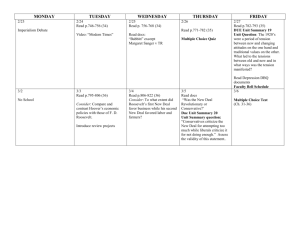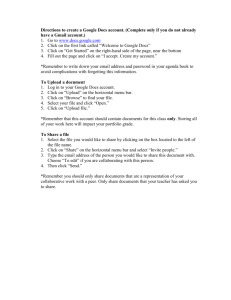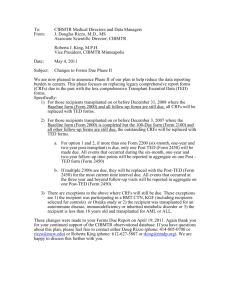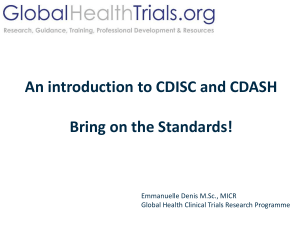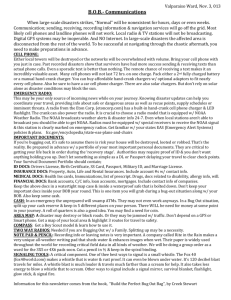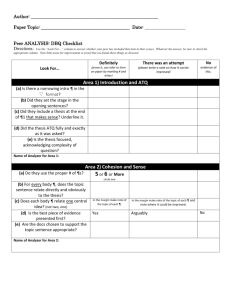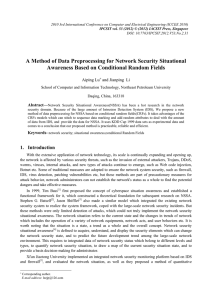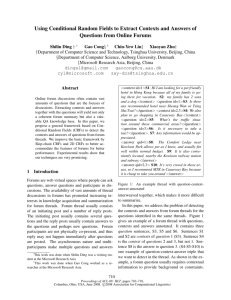Source Documents for Clinical Trial Visits
advertisement
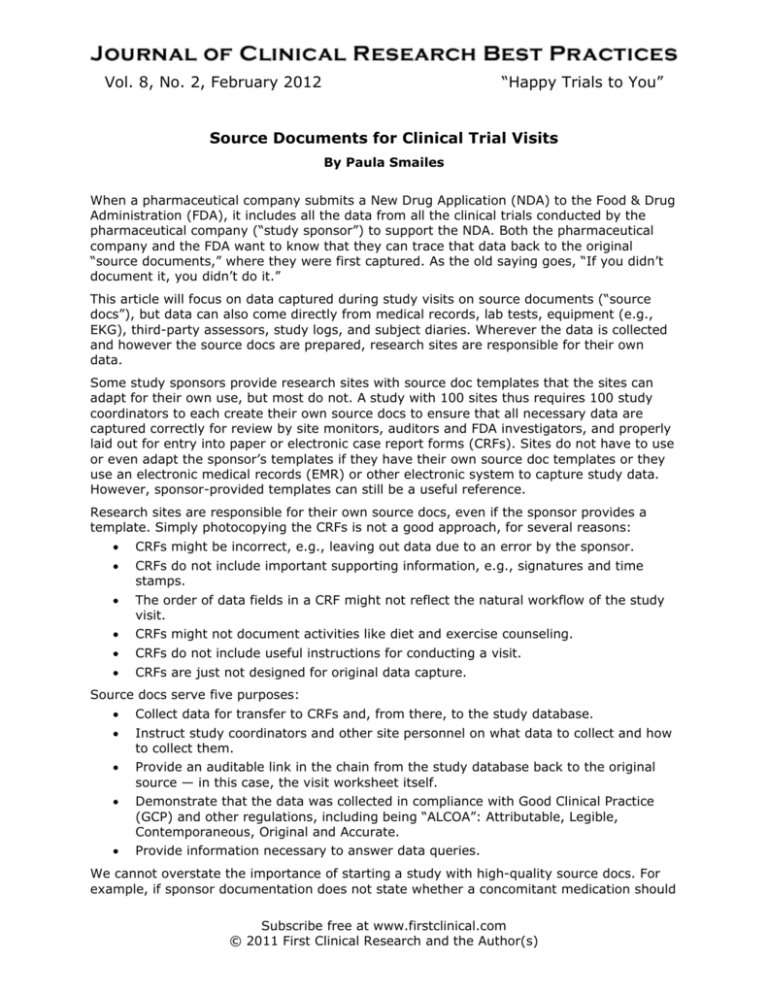
Vol. 8, No. 2, February 2012 “Happy Trials to You” Source Documents for Clinical Trial Visits By Paula Smailes When a pharmaceutical company submits a New Drug Application (NDA) to the Food & Drug Administration (FDA), it includes all the data from all the clinical trials conducted by the pharmaceutical company (“study sponsor”) to support the NDA. Both the pharmaceutical company and the FDA want to know that they can trace that data back to the original “source documents,” where they were first captured. As the old saying goes, “If you didn’t document it, you didn’t do it.” This article will focus on data captured during study visits on source documents (“source docs”), but data can also come directly from medical records, lab tests, equipment (e.g., EKG), third-party assessors, study logs, and subject diaries. Wherever the data is collected and however the source docs are prepared, research sites are responsible for their own data. Some study sponsors provide research sites with source doc templates that the sites can adapt for their own use, but most do not. A study with 100 sites thus requires 100 study coordinators to each create their own source docs to ensure that all necessary data are captured correctly for review by site monitors, auditors and FDA investigators, and properly laid out for entry into paper or electronic case report forms (CRFs). Sites do not have to use or even adapt the sponsor’s templates if they have their own source doc templates or they use an electronic medical records (EMR) or other electronic system to capture study data. However, sponsor-provided templates can still be a useful reference. Research sites are responsible for their own source docs, even if the sponsor provides a template. Simply photocopying the CRFs is not a good approach, for several reasons: CRFs might be incorrect, e.g., leaving out data due to an error by the sponsor. CRFs do not include important supporting information, e.g., signatures and time stamps. The order of data fields in a CRF might not reflect the natural workflow of the study visit. CRFs might not document activities like diet and exercise counseling. CRFs do not include useful instructions for conducting a visit. CRFs are just not designed for original data capture. Source docs serve five purposes: Collect data for transfer to CRFs and, from there, to the study database. Instruct study coordinators and other site personnel on what data to collect and how to collect them. Provide an auditable link in the chain from the study database back to the original source — in this case, the visit worksheet itself. Demonstrate that the data was collected in compliance with Good Clinical Practice (GCP) and other regulations, including being “ALCOA”: Attributable, Legible, Contemporaneous, Original and Accurate. Provide information necessary to answer data queries. We cannot overstate the importance of starting a study with high-quality source docs. For example, if sponsor documentation does not state whether a concomitant medication should Subscribe free at www.firstclinical.com © 2011 First Clinical Research and the Author(s) be listed by its trade name or generic name, the site should clarify the ambiguity upfront, rather than wait to find out that eight months of monitored data have to be corrected. It is good practice to have the site monitor and a third set of eyes review source docs before they are put into use. How to Create Source Docs Information for creating source doc worksheets can be found in multiple places: The CRFs. The CRFs should set forth details like units of measurement (e.g., kilograms or pounds). In theory, if the CRF does not ask for a piece of data, the study sponsor does not want it, but sponsors occasionally make mistakes in creating CRFs. The Protocol Schedule of Events. The Schedule of Events gives a visit-by-visit overview of the study. Each visit needs its own source doc(s). Other Parts of the Protocol. The body of the protocol describes much or all of the data to be collected. More importantly, it provides information on how the data is to be collected. For example, the protocol might state, “The first blood pressure reading will be taken after the subject has been prone for five minutes and a second reading will be taken three minutes later.” There also might be useful information in protocol footnotes and appendices. Laboratory Manual, Study Manual, Informed Consent Form, Adverse Event Log, Concomitant Medication Log, Study Budget, etc. These documents might reveal requirements and details that are not explicit in the CRFs or Protocol, or were not noticed previously. The Site’s Standard Source Docs. Many sites develop their own standard templates for collecting data on the subject’s history, physical exam, concomitant medications, common assessments, etc. These templates can be modified for a particular study. Use the Schedule of Events to identify study visits. For each visit, start with a source doc template (or CRF page). If necessary, move the document into an editable file. Then go through the CRFs, protocol and other study documents looking for pertinent information. Modify the source doc as appropriate. Include questions for later clarification, e.g., at the site initiation visit. If you do not yet have access to the CRFs, you can still create a draft version of the source docs and then check them later against the CRFs. As a final step, review the source docs to make sure they include all the relevant information in a form that is easy to understand, easy to complete, and flows naturally with the study visits. This is a good time for a second set of eyes to review the source docs. The site monitor should also review them. What to Include in Source Docs Ideally, site personnel should not have to read the protocol during a study visit to know what to do, when to do it, and how to do it. Put yourself in the shoes of an FDA investigator trying to trace data and reconstruct events two years after the study ends and all personnel are gone. Source docs should include the following types of information: Header information, such as site name, study number and/or short name, subject initials and/or number, and visit date. Data entry fields with clear labels, units of measure, and instructions (including when to skip a field). Subscribe free at www.firstclinical.com © 2012 First Clinical Research and the Author(s) 2 Fields to explain the source of data not collected during the visit, e.g., from a medical record. Fields for data that are not included in the CRFs, typically to document activities, e.g., “Subject fasted (no food or drink) for 8 hours prior to visit. Yes: [ ] No: [ ]” Additional instructions, e.g., “Obtain study drug from pharmacy NOW,” “Make sure crash cart is close by,” or “Call IVRS to enter visit.” Some of these instructions might be excerpts from the protocol. Refer to specific pages and sections of the protocol, when useful. Spaces for names, signatures (or initials), and dates (and times) on each page for each person who contributes data to the page, e.g., if the investigator performs an assessment in the middle of a visit. Conclusion Clinical trials are scientific experiments designed to collect data under controlled conditions. Well-designed source docs are the data foundation of a successful clinical trial. Creating source docs is also an excellent way to thoroughly learn a study and clarify any ambiguities. Author Paula Smailes, RN, MSN, CCRC, CCRP is a Clinical Research Specialist at The Ohio State University Department of Family Medicine. Contact her at 1.614.293.3644 or paula.smailes@osumc.edu. Subscribe free at www.firstclinical.com © 2012 First Clinical Research and the Author(s) 3
